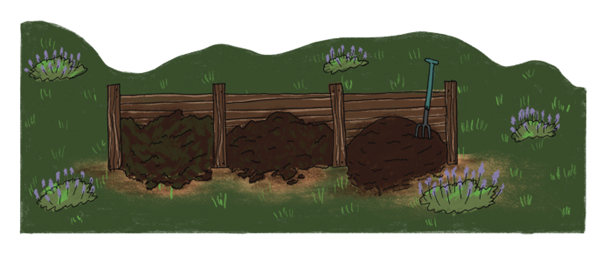Farm practices to increase biodiversity and enhance ecosystem services
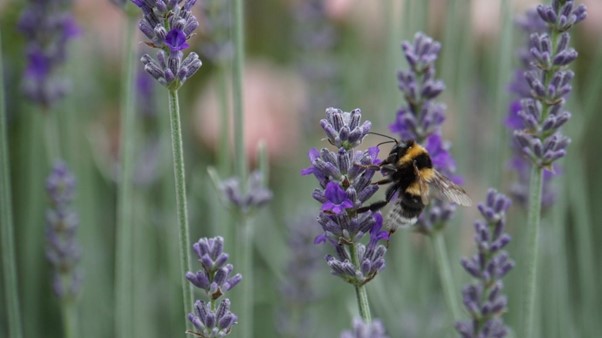
This post is also available in:
This post is also available in:
![]() Deutsch (German)
Deutsch (German) ![]() हिन्दी (Hindi)
हिन्दी (Hindi) ![]() Türkçe (Turkish)
Türkçe (Turkish) ![]() Ελληνικά (Greek)
Ελληνικά (Greek) ![]() Português (Portuguese (Brazil))
Português (Portuguese (Brazil))
The article was written by Clara Bosch and revised by Yanniek Schoonhoven. Milan Teunissen van Manen made the illustrations.
“Biodiversity is the diversity among living organisms, which is essential to ecosystem function and services delivery.”
In the last decades, we have simplified agroecosystems to pursue higher production. Still, nowadays, we realise how vital the correct functioning of ecosystems is for our survival. For example, monoculture farming practices reduce the amount of habitat for biodiversity. At the same time, this increases the susceptibility of crops to pests and diseases. In addition, many crops would fail if pollinating insects disappeared. But how can you use the benefits of rich biodiversity on your farm? How can you promote it? Discover it through this article.
“If we simplify the agroecosystem, we eliminate important relationships like predation or parasitism, which can lead to an overpopulation of certain species and create problems for crops such as pests or diseases. Therefore, we must seek balance by diversifying so that species help us, which does not mean giving up production but rather understanding the ecosystem”.
-Fernando Bautista, biodiversity consultant of the Alvelal Association-
Maintaining a balance between productivity, biodiversity, and landscape beauty is possible and necessary. Certain species and landscape elements help us by providing essential ecosystem services, such as forming soil, providing food and fibers, regulating water, and having cultural and aesthetic value. Soil health and life are crucial for nutrient cycling and plant growth. They also control the Earth’s climate by affecting carbon storage in the soil. Plants, trees, and algae absorb carbon dioxide and create oxygen through photosynthesis.
Examples of ecosystem services provided by biodiversity:
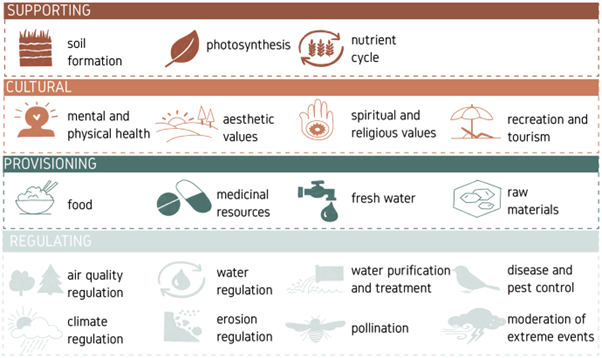
Different species and landscape elements can be included to promote biodiversity at different scales. You can look at soil, field, farm, and landscape levels to encourage soil life, arthropods (insects), macrofauna, or particular plant species. Something to always consider when promoting (animal) species is their food, water, and shelter needs in their different life cycles and seasons.
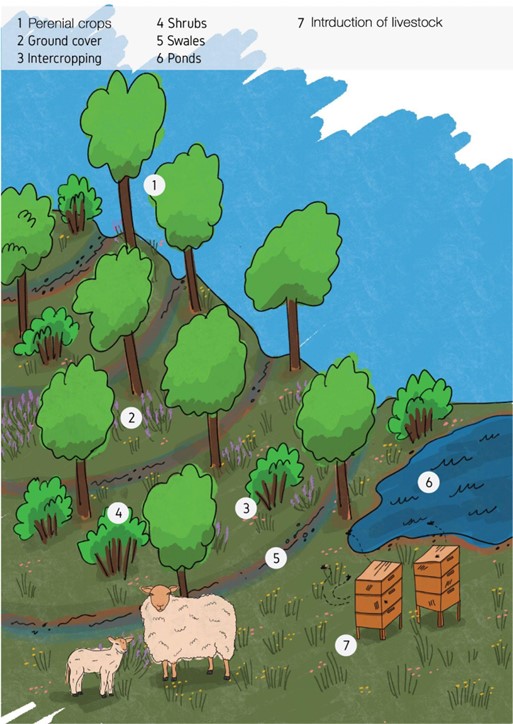
Practices that can help improve biodiversity, graphic designed by Milan Teunissen van Manen
Practices:
1. Ponds
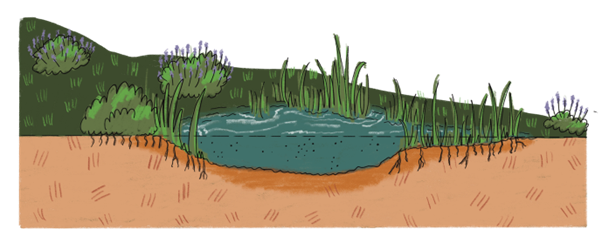
Pond illustration by Milan Teunissen van Manen
Access to water is crucial to animals and will create a microclimate for different plant species. They will significantly affect insect populations, birds, and animals. You can have limited access to water with, for example, a bucket that you fill up regularly, or if you want to think big, you can create a natural pond that fills up with rainwater.
Pollinators and honeybees need these water sources to survive, cool down the hives, and dissolve hardened honey. The shorter the distance they travel to find water, the more time they can spend pollinating the crops.
Increasing the habitats for all this biodiversity makes it possible to improve natural pest control. (More birds that prey on insects, or more ladybugs that eat aphids).

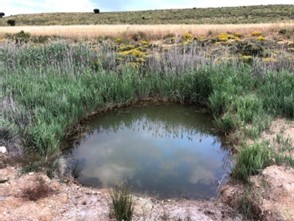

Ponds at Camp Altiplano, La Junquera farm.
2. Swales

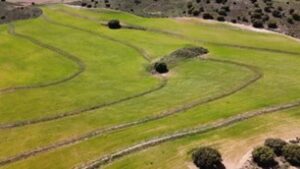
Illustration of swales by Milan Teunissen van Manen Swales at La Junquera Farm
On sloped areas, swales can help you control erosion and retain water on your farm. Any practice that reduces erosion and improves the water retention of your soils will help promote healthy soil life since most microorganisms and fungi live in the top 10 cm of the Earth, which is prone to be lost in erosive events when it is not protected.
Swales can also be combined with vegetation strips and hedges on top of them, which will multiply the beneficial effects on biodiversity by enhancing the habitat.

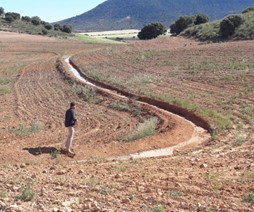
Swale at la Junquera Farm
3. Flower strips, hedges, biodiversity islands.
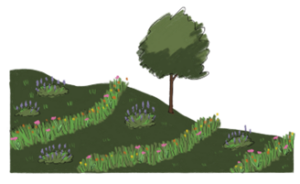
Flower strips representation by Milan Teunissen van Manen
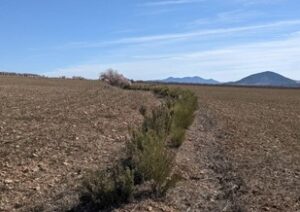
Aromatic hedge at Manuel Martinez farm, Alvelal Association
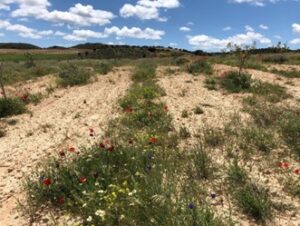
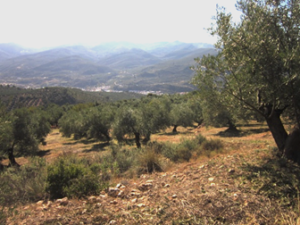
Flower strip between pistachios, La Junquera Biodiversity island at Martin Moreno’s Farm, Oleai cooperative
Vegetation strips can be perennial (think of aromatic plants and bushes) or seeded (annual flowers and other exciting species such as nitrogen fixers, grains, etc.). And they can be located around the field, in designated areas (creating islands), or as an intercrop inside the field.
If you are interested in increasing pollination, consider adding flowering plants that are attractive to pollinating insects. Examples of species are lavender, sweet marjoram, fennel, sunflowers, etc. To improve this effect, try to have a variety of flowers available throughout the year in the farm’s designated area to ensure a consistent presence of pollinators. Below is an example of how to plant a hedge for biodiversity.

Example of creating a hedge to promote biodiversity includes trees, shrubs, and aromatics. Image extracted from the hedge handbook designed by Laetitia Boels. This handbook contains suitable plant species for the Mediterranean drylands. You can find a link to it in the sources below.
Permanent hedges can provide habitat to many different species. Inside the hedge, you can choose species with other functions that benefit the crop or specific species of interest. In our context, wild roses, junipers, and sea-buckthorn, for example, give food to birds and foxes. At the same time, they will also provide shelter to many insects. The species in the hedges may vary per region, so look up which ones suit your context and goals.

4. Ground covers and green manures
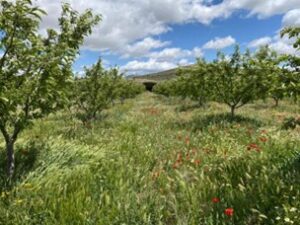
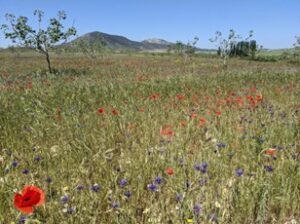
Green manures at La Junquera Farm, apple orchard, left, and pistachio orchard, right.
Ground covers can be seeded, sometimes called green manures, or they can be spontaneous, grown by themselves. They usually contain a mixture of legumes (fixing nitrogen) and cereals (deep rooting and carbon sequestration). We can keep them all year round or for a particular time on the fields.
Ground covers protect the soil from being eroded and from the sun. They can work as a living mulch and create a habitat for many soil organisms and arthropods. The root exudates of the plants will benefit an active soil life.
If the ground cover competes with your main crop, you can also seed it in strips. For example, if you have a tree crop, you can plant a strip of 1m to 3m between two rows.

5. Mulch
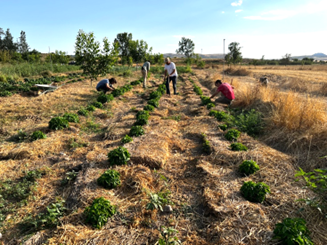
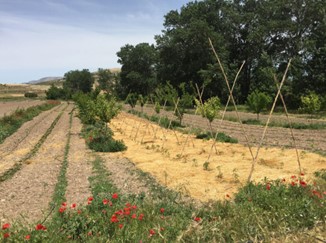
Straw mulch at the vegetable garden at La Junquera Farm
Mulching the soil provides the nutrients needed by decomposers. It also retains moisture in the ground, protects the Earth from solar radiation, and provides a more favourable environment for earthworms and other soil life.

6. Compost and microorganism preparations
Compost representation by Milan Teunissen van Manen
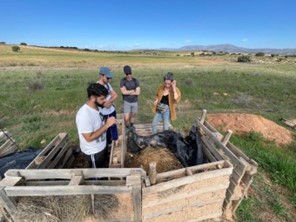

Compost infrastructure at Camp Altiplano Making the Maria-Thun Preparate, Junquera


Compost check at La Junquera Farm Vermicompost project at La Junquera
Compost is humus-like material made from decayed organic matter through the activity of soil microorganisms. It contains many beneficial soil microorganisms and provides the nutrients and habitat for others to prosper when added to the soil. We make it out of leftover crop material, manure, straw, and ashes. To complete the process, we need to keep it moist and oxygenated. There are many types of compost, such as vermicomposting or Bokashi.
There exist other ways of promoting microorganisms. There are different preparation from biodynamic farming and other farming streams. We will not go in-depth in this article. Examples are: “reproduction of mountain microorganisms” and “Maria Thun preparation, from biodynamic farming.”

7. Crop Rotations, Intercropping
Crop rotation involves growing different crops in one specific field in a particular sequence. This way, we can reduce pest and disease problems, improve soil health and fertility, and increase the diversity of habitats for life. Intercropping, or growing two or more crops in the same field simultaneously, can also increase biodiversity by providing a range of habitats for wildlife.

8. Integration with livestock
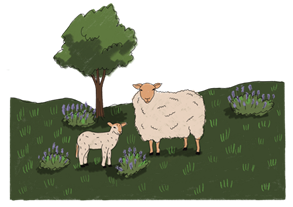
Sheep as a an example for integration of livestock, illustration by Milan Teunissen van Manen

Sheep rearing under almond trees in AlVelAl Association

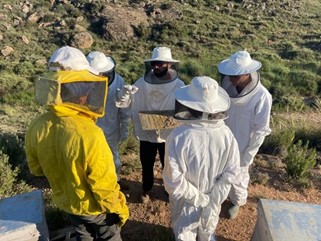
Holistic grazing at La Junquera Farm Beekeeping by Guatazales
The introduction of livestock on a farm can significantly impact biodiversity by creating new habitats and increasing soil fertility. In this case, we mean livestock kept extensively, in holistic management, and in symbiosis with other farm elements. Many different types of livestock can be introduced, including cows and sheep for grazing, bees for pollination, ducks and chickens for pest control, and more. Each animal has its unique function and can contribute to the overall health and productivity of the farm ecosystem. For example, grazing animals can help control weeds, prevent erosion by maintaining ground cover and even serve as a fire prevention measure in natural areas. Additionally, livestock can help sequester carbon and produce manure which can be used to enhance soil fertility.

9. Insect, reptile, birt and bats housing and poles for predatory birds.
Insect hotel at Camp Altiplano

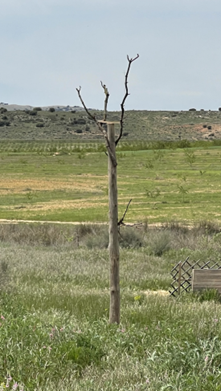
A pile of stones can create a habitat for reptiles and amphibians Pole to host predatory birds, Camp Altiplano
These animals can provide essential ecosystem services, such as pollination and pest control, which can benefit crops and the overall health of the agroecosystem.
One way to provide habitat or nesting sites for these animals is to construct “housing.” This construction can be as easy as a pile of rocks, for reptiles, or wooden logs. Poles for predatory birds can provide a viewpoint over the fields to control pests, such as insects or rabbits, by birds, such as kestrels and barn owls. You can also create the cute insect houses a lot of people make.

10. Reduced/no use of chemical pesticides, fungicides and fertilisers.
Reduced/no use of chemical pesticides, fungicides, and fertilizers can positively impact biodiversity. When these chemicals are overused, they can harm or kill beneficial insects, birds, and other animals that play a crucial role in maintaining a healthy ecosystem. Additionally, these chemicals can also contaminate soil and water, which can harm other forms of life. By reducing the use of these chemicals, we can help protect and preserve a wide range of plant and animal species, which can help maintain a healthy and balanced ecosystem. Furthermore, reducing the use of these chemicals can also help reduce the risk of developing resistance to pests and can help reduce the economic costs associated with the overuse of these chemicals.
Additionally, farmers can use integrated pest management strategies. Integrated pest control is a method of managing pests that utilises various techniques, including biological control, cultural control, and physical control. It includes the practices explained above. It can be more effective at controlling pests in the long term. Using various techniques and integrated pest control can help enhance the balance of the ecosystem and promote biodiversity.

Conclusion:
In conclusion, promoting farm biodiversity can benefit farmers, the environment, and the wider community. It can help to improve soil health, increase crop resilience, and support a diverse range of species. Diversity is the key when it comes to promoting biodiversity on farms. A mosaic landscape with various habitats can support species and provide essential ecosystem services. It’s important to think of your whole farm as a system rather than just individual fields. By considering the interactions between different parts of the farm and how they contribute to the ecosystem’s overall health, you can make impactful decisions.
In summary, promoting biodiversity on farms can be achieved by creating a mosaic landscape that supports a wide range of species, thinking of the farm as a system by providing a variety of habitats, food sources, and nesting sites and utilizing techniques such as crop rotation, intercropping or compost. You can decide the ones that make sense in your specific context.

Webography and other interesting resources:
- What is regenerative agriculture? From Wikifarmer platform: https://wikifarmer.com/regenerative-agriculture-what-is-it-who-is-it-for-common-practices-principles-and-resources/
- EIT food manuals on regenerative agriculture, they explain the pratices more in detail for different mediterranean crops, behind the registration form you can find them all for free: https://www.eitfood.eu/reports/regenag-manual
- Soil carbon sequestration – An interplay between soil microbial community and soil organic matter dynamics: https://www.sciencedirect.com/science/article/abs/pii/S0048969722000171
- Why do we need to protect biodiversity? https://ec.europa.eu/environment/nature/biodiversity/intro/index_en.htm
- Plants for a hedge in La Junquera, handbook by Laetitia Boels: https://drive.google.com/file/d/1izN9r1dyLO07M7k4TDJpb4VHlephnb0M/view?usp=sharing
- Why does biodiversity matter for agriculture? https://www.thesciencebreaker.org/breaks/earth-space/why-does-biodiversity-matter-for-agriculture
- FUNCTIONAL BIODIVERSITY: https://dicoagroecologie.fr/en/dictionnaire/functional-biodiversity/#:~:text=Functional%20biodiversity%20refers%20to%20the,the%20farmer%20through%20environmental%20management.
- Biodiversity and Ecosystem Services: Is It the Same Below Ground?: https://www.nature.com/scitable/knowledge/library/biodiversity-and-ecosystem-services-is-it-the-96677163/
- The power of pollinators: why more bees means better food, from FAO:
https://www.fao.org/zhc/detail-events/en/c/428504/ - Biodynamic preparations explained by Demeter: https://demeter.net/wp-content/uploads/2021/05/Demeter-Biodynamic-Preparations-Manual_2020.pdf
If you want to read more about biodiversity and farm practices, check the articles below:
Farm practices to increase biodiversity and enhance ecosystem services
Regenerative Agriculture: What is it? Who is it for? Common practices, principles and resources



















